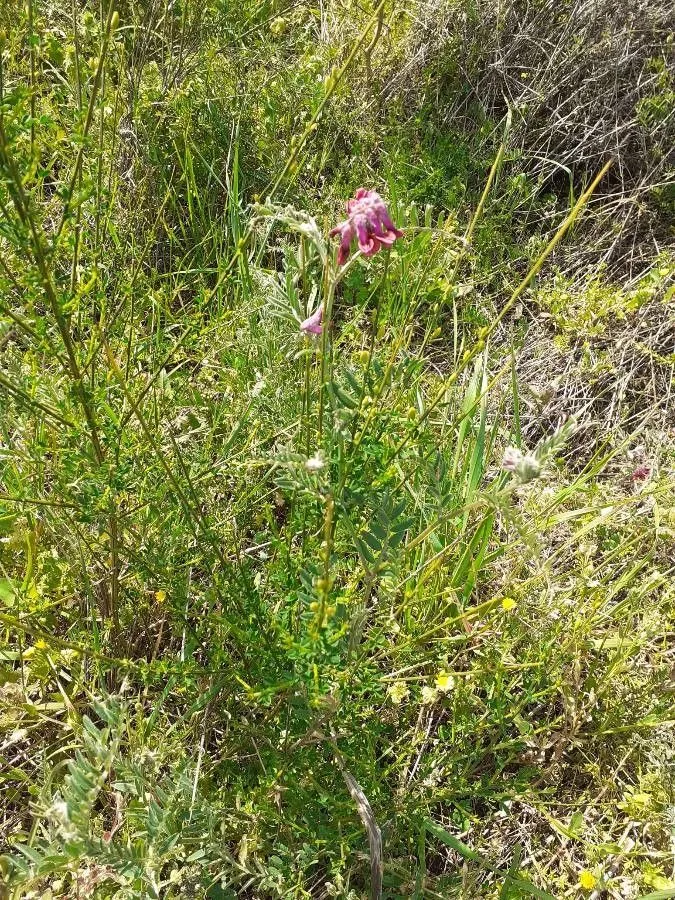
Author: L.
Bibliography: Sp. Pl.: 736 (1753)
Year: 1753
Status: accepted
Rank: species
Genus: Vicia
Vegetable: False
Observations: Madeira, S. Europe, NW. Africa
Algerian vetch, known scientifically as Vicia benghalensis, is a fascinating plant that has garnered attention due to its unique characteristics and wide geographic distribution. Belonging to the family Fabaceae, this species is a testament to the remarkable diversity found within the legume family.
Originally described in 1753 by the renowned botanist Carl Linnaeus, Vicia benghalensis has a long history of botanical interest. It thrives in various regions, including Madeira, Southern Europe, and Northwestern Africa. These areas provide the ideal climate and soil conditions that allow Algerian vetch to flourish, showcasing its adaptability and resilience.
The plant typically features characteristics common to legumes, including compound leaves and a vining growth habit that enables it to climb or spread over the ground. Its flowers, which are usually purplish or pink, contribute to its aesthetic appeal and play a crucial role in pollination. The pods that follow contain seeds which are vital for the propagation of the species.
Ecologically, Algerian vetch performs essential functions in its native habitats. Like many legumes, it is capable of nitrogen fixation, a process where nitrogen gas from the atmosphere is converted into ammonia, enriching the soil. This process not only supports the plant’s growth but also enhances soil fertility, benefiting other plants in the ecosystem.
In addition to its ecological contributions, Vicia benghalensis has been utilized in agriculture. It is often incorporated into crop rotations and used as a cover crop to improve soil structure, control weeds, and prevent erosion. Its ability to fix nitrogen makes it an invaluable asset in sustainable farming practices, reducing the need for chemical fertilizers.
Overall, Algerian vetch epitomizes the intricate connections between plants and their environments. Its study and cultivation offer insights into sustainable agricultural practices and highlight the importance of biodiversity in ecological health. As we continue to explore the potential of Vicia benghalensis, it remains a symbol of the enduring relationship between nature and human cultivation practices.
Eng: algerian vetch, purple vetch, reddish tufted vetch
Dan: azorisk vikke
Heb: bakia argemanit, בקיה
Deu: bengalen-wicke, purpurwicke
Por: ervilhaca
Cat: garlanda atropurpúria
Swe: purpurvicker
Ita: veccia del bengala
Fra: vesce de bengale, vesce pourpre foncé
Spa: veza purpúrea
Cym: ffacbys porffor, ffacbysen borffor
En: Algerian vetch, Purple vetch, Reddish tufted vetch, Winter Vetch
Af: Pers wiek
Ar: بيقية بنغالية
Bg: Бенгалска глушина
Ca: Veça vermella, Garlanda atropurpúria
Da: Azorisk vikke
Fr: Vesce de Bengale, Vesce pourpre foncé, Vesce du Bengale
De: Purpurwicke, Purpur-Wicke, Bengalen-Wicke, Bengalische Wicke, Benghal-Wicke
He: Bakia argemanit, בקיה, בקיה ארגמנית
It: Veccia del Bengala, Veccia rosso-nera
Fa: ماشک ارغوانی
Pt: Ervilhaca-vermelha, Ervilhaca
Es: Veza purpúrea, Alverjilla de Bengala, Arveja roja
Sv: Purpurvicker
Cy: Ffacbysen borffor, Ffacbys Porffor
Taken Mar 4, 2020 by Moschetto gino (cc-by-sa)
Taken May 13, 2021 by Emmanuel Cosson (cc-by-sa)
Taken Mar 21, 2021 by tonysalix77 (cc-by-sa)
Taken Mar 20, 2021 by Prieta Javier (cc-by-sa)
Taken Mar 27, 2019 by Andrés González Muñoz (cc-by-sa)
Taken Nov 18, 2021 by Diego Alex (cc-by-sa)
Taken Nov 18, 2021 by Diego Alex (cc-by-sa)
Taken May 7, 2001 by Tela Botanica − Liliane ROUBAUDI (cc-by-sa)
Taken Mar 20, 2021 by Prieta Javier (cc-by-sa)
Taken Mar 4, 2020 by Moschetto gino (cc-by-sa)
Taken May 17, 2019 by Tela Botanica − José Luis Romero Rego (cc-by-sa)
Taken Apr 3, 2021 by Mario Cannata (cc-by-sa)
Taken May 7, 2001 by Tela Botanica − Liliane ROUBAUDI (cc-by-sa)
Taken Apr 30, 2019 by Llandrich anna (cc-by-sa)
Taken May 13, 2021 by Emmanuel Cosson (cc-by-sa)
Taken Apr 9, 2017 by Pedro Salgadinho (cc-by-sa)
Taken Mar 15, 2009 by Photoflora – Benoit BOCK (©)
Taken Mar 15, 2009 by Photoflora – Benoit BOCK (©)
Taken May 7, 2020 by Llandrich anna (cc-by-sa)
Taken Apr 30, 2019 by Llandrich anna (cc-by-sa)
Taken May 1, 2017 by Tela Botanica − Liliane ROUBAUDI (cc-by-sa)
Taken May 7, 2001 by Tela Botanica − Liliane ROUBAUDI (cc-by-sa)
Taken Apr 29, 2016 by Tela Botanica − Bruno MACÉ (cc-by-sa)
Taken Mar 20, 2021 by Prieta Javier (cc-by-sa)
Taken Apr 30, 2019 by Llandrich anna (cc-by-sa)
Taken May 15, 2016 by Photoflora – Jean-Luc TASSET (©)
Taken Apr 15, 2015 by Photoflora – Jean-Luc TASSET (©)
Taken Apr 15, 1988 by Photoflora – Jean-Luc TASSET (©)
Taken Jan 1, 1970 by Photoflora – L’Abbé COSTE (©)
Taken May 14, 2022 by de Toro Cacharrón (cc-by-sa)
© copyright of the Board of Trustees of the Royal Botanic Gardens, Kew.
Growth form: Single Stem
Growth habit: Vine, Forb/herb
Ph maximum: 7.5
Ph minimum: 7.0
Light: 7
Atmospheric humidity: 4
Bloom months: [‘apr’, ‘may’, ‘jun’]
Soil nutriments: 6
Family: Myrtaceae Author: (F.Muell.) K.D.Hill & L.A.S.Johnson Bibliography: Telopea 6: 402 (1995) Year: 1995 Status:…
Family: Rubiaceae Author: Pierre ex A.Froehner Bibliography: Notizbl. Bot. Gart. Berlin-Dahlem 1: 237 (1897) Year:…
Family: Sapindaceae Author: Koidz. Bibliography: J. Coll. Sci. Imp. Univ. Tokyo 32(1): 38 (1911) Year:…
Family: Asteraceae Author: A.Gray Bibliography: Pacif. Railr. Rep.: 107 (1857) Year: 1857 Status: accepted Rank:…
Family: Fabaceae Author: Medik. Bibliography: Vorles. Churpfälz. Phys.-Ökon. Ges. 2: 398 (1787) Year: 1787 Status:…
Family: Aspleniaceae Author: (Cav.) Alston Bibliography: Bull. Misc. Inform. Kew 1932: 309 (1932) Year: 1932…